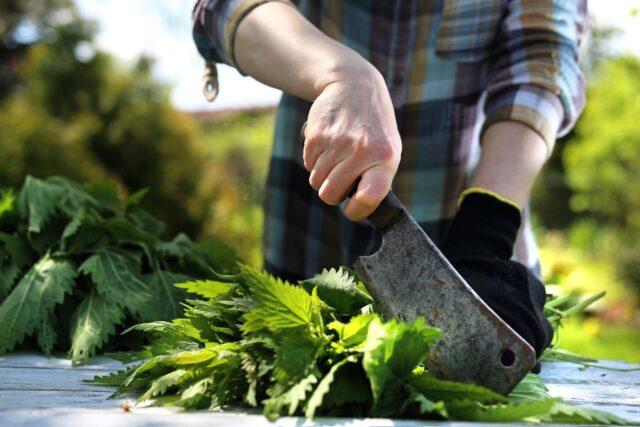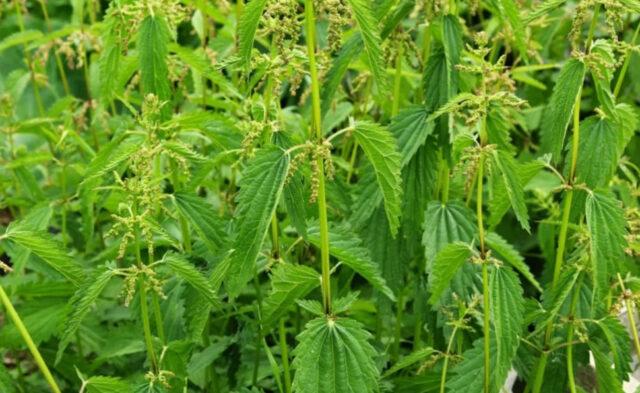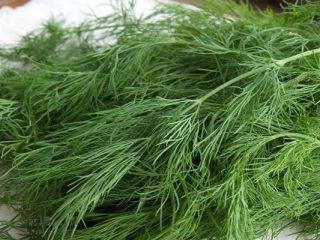Content
Many people are familiar with the situation when walks through grassy thickets in nature end with the appearance of blisters on the skin, their unbearable itching and a spoiled mood. This is how nettle stings; it is a well-known medicinal plant that only brings benefits when used skillfully. It is worth understanding the causes of burns and deciding on first aid methods.

Nettle contains many vitamins, microelements and amino acids
Why does nettle burn?
In order to see the nettle, you don’t need eyes; it itself will let you know that it is nearby. No wonder it was called fire-grass, witch's whip or green boiling water. Those who have at least once been burned by nettles agree with these definitions.
In fact, the plant’s “acute” reaction is associated with a method of personal self-defense from animals ready to eat it. Knowing this feature, the latter bypass the bushes, giving them the opportunity to grow, spread, quickly capturing and developing new territories.
Nettle stings or stings
The opinion that nettle stings is incorrect. Its effect on human skin can be compared to mosquito bites, both in terms of the main mechanism and the consequences (redness, blisters, itching).
All the leaves and stem of the plant look soft and velvety in appearance due to the hairs that densely cover them over the entire surface. This impression is deceptive, since they are the reason that nettles sting and bite. When the hairs come into contact with the skin, they dig into it like mosquito proboscis and release substances that cause irritation.
What substance does nettle burn with?
On the hairs of the plant there are small sacs that look like capsules filled with juice with a sharp tip. At the moment of contact, the tip breaks, the contents are injected under the skin and an instant reaction is observed caused by the substances included in the juice:
- choline;
- serotonin;
- histamine;
- formic acid.
Histamine causes an instant allergic reaction - a rash on the skin in the form of blisters and redness, and formic acid burns at the site of contact with the plant.

Nettle leaves can be used to store perishable foods
What does a nettle burn look like?
Burn symptoms appear immediately after contact with the plant:
- An acute, short-lived pain occurs (about 10-15 minutes).
- Redness, swelling, and increased temperature develop in the affected area.
- Blisters and itching appear.
Sometimes nettle stings so much that allergic attacks are observed, characterized by symptoms:
- General weakness occurs.
- Body temperature rises.
- Shortness of breath appears.
In this case, it is necessary to urgently seek medical help from specialists. It is worth consulting a doctor if a nettle burn that looks like the one in the photo does not go away within 24 hours.

Nettle of some tropical species stings so much that you can die from touch.
What are the benefits of stinging with nettles?
Not everything is so critical if you cannot avoid contact with nettles and it stings. It is not for nothing that the plant is classified as a medicinal plant; it has long been used in folk and official medicine to treat many diseases. It is eaten and used in cosmetology. Therefore, there are benefits and positive aspects to nettle burns.
What are the benefits of nettle burns?
When the tips of the capsules located on the stems and leaves pierce the skin, blood rushes to the epidermis, stimulating the functioning of the capillaries and the entire circulatory system. This effect is often used to treat varicose veins, atherosclerosis, rheumatism, arthritis, to ensure a flow of blood to the right place.
The reason that nettle stings is due to the presence of formic acid, which can have not only an irritating effect, but also an antiseptic, anti-inflammatory and analgesic effect. Choline, which is part of the juice, helps reduce the level of bad cholesterol and strengthen cell membranes. Serotonin helps remove toxins from the body.
Why is nettle burn harmful to the skin?
Most often, the greatest harm caused by stinging nettles comes down to temporary discomfort, minor swelling and redness. They pass relatively quickly and do not carry any serious consequences.
Allergic reactions to formic acid, histamine, serotonin and choline sometimes occur. In this case, you will need to take antihistamines and anti-inflammatory drugs according to the dosage and regimen prescribed by the doctor.

The painful condition from a burn can last up to three days.
How to get rid of a nettle burn
If the nettle stings and itchy blisters form on your skin, this is not a reason to panic. There are many options for help at this point. It all depends on how severe the pain and redness is. You can use both time-tested folk methods and medicines.
First aid for nettle burns
If there is a strong burning sensation at the site of the lesion, then first you need to clean the surface of the skin. To do this, moisten a napkin in cold water and wipe the affected area. Hair can be removed using adhesive tape, which is first applied to the skin and then torn off. It will take the stuck ends of the capsules with it. Next, treatment is carried out with hydrogen peroxide or another disinfectant solution.
The nature of first aid depends on where the person is, how badly the skin burns at the site of the injury, and what remedies are available at that moment.
Outdoors
You can relieve pain from nettle burns while outdoors in one of the following ways:
- Find plantain or sorrel leaves, wash them, rub them in your hands and apply to the place where it burns.
- Rinse skin with plenty of cold water.
- Make a mud lotion, dry it and remove it so that the plant hairs are removed along with the soil.

The tips of the hairs are very sharp and consist of silicon salt
At home
At home, you can get rid of the stinging sensation of nettles using baking soda. A paste is made from it and applied to the affected area. The powder neutralizes formic acid, inflammation subsides.
As an alternative, treatment with table vinegar and laundry soap diluted with boric or salicylic alcohol is acceptable.
An area of skin that is red and burning is treated with aloe juice or ice cubes made from it. Ordinary ice or any frozen product wrapped in a towel can relieve the condition a little.
With the help of medications
If folk remedies do not have the desired effect and the affected area still burns, becomes inflamed, and itches, then use medicines for nettle burns:
- Menovazin, Fenistil - antipruritic and analgesic ointments.
- Aspirin, Paracetamol - relieves swelling and inflammation.
- Tavegil, Suprastin, Claritin are antihistamines that can stop an allergic reaction.

The plant is used as a hemostatic, choleretic and anti-inflammatory agent.
What to do if a child is burned by nettles
A child's skin is more sensitive than that of adults, and even at the slightest touch of nettle it becomes inflamed and painful. Young children may scratch the affected area and further injure it. Therefore, urgent measures need to be taken:
- Rinse skin with cold water.
- Treat it with a solution of alcohol or vodka.
- If blisters appear, apply a lotion with a 1% boric acid solution.
- Apply anti-inflammatory ointment to the affected area (Bepanten, Acyclovir).
Later, the child needs to be shown the plant and explain how he received the sting from the nettle, why it stings, so that in the future the child will avoid it and not touch it.
In what cases should you consult a doctor?
Immediate medical attention is required if a person is allergic to any of the substances contained in nettle juice. To recognize the reaction, it is necessary to monitor the condition and call an ambulance in the following situations:
- difficulty breathing;
- a feeling of tightness in the chest;
- swelling of the mouth, lips, tongue;
- rash spreading throughout the body;
- cramps, vomiting, diarrhea.
It is worth contacting a pediatrician if a small child has been burned and has at least one of the listed symptoms.
Medical attention is needed if not only severe nettle burns are received, but also an infection occurs, in which the skin burns, is inflamed and is hot to the touch.
How to avoid nettle sting
When going to the forest, river or dacha, it’s difficult to sit still. While playing football or just walking, you may not notice how the nettles are already stinging, because you find yourself in its thickets. To avoid having to get rid of itching from nettles in the future, you should listen to the advice:
- Examine the clearing and mark dangerous places, cover them with branches or fence them off with tape.
- Avoid shorts and short-sleeved T-shirts in favor of clothing that covers your legs and arms.
- Show the children the plant, explain how it burns, and vividly describe the possible consequences of contact with it.
- Bring first aid supplies with you.

Stinging nettle grows up to 2 m in height and forms dense thickets
What to do to prevent nettles from burning
Nettle is considered an excellent fertilizer; an infusion is made from it, which is used to feed garden crops. The plant is used for food, preparing salads, first courses, and vitamin seasonings. Its medicinal properties are widely known.
To prepare raw materials, you must act carefully, since nettles burn. However, if you carefully grasp the stem, pressing the hairs, they will not cause any harm. During cooking, the foliage is quickly doused with boiling water and rinsed with cold water, after which it does not burn your hands.
Conclusion
There is nothing wrong with the fact that nettles sting - this is a self-preservation reaction of the plant. Most often, the burns it inflicts are minor and go away quickly. You should not be afraid of them, and you should only start worrying if you experience an allergic reaction.








